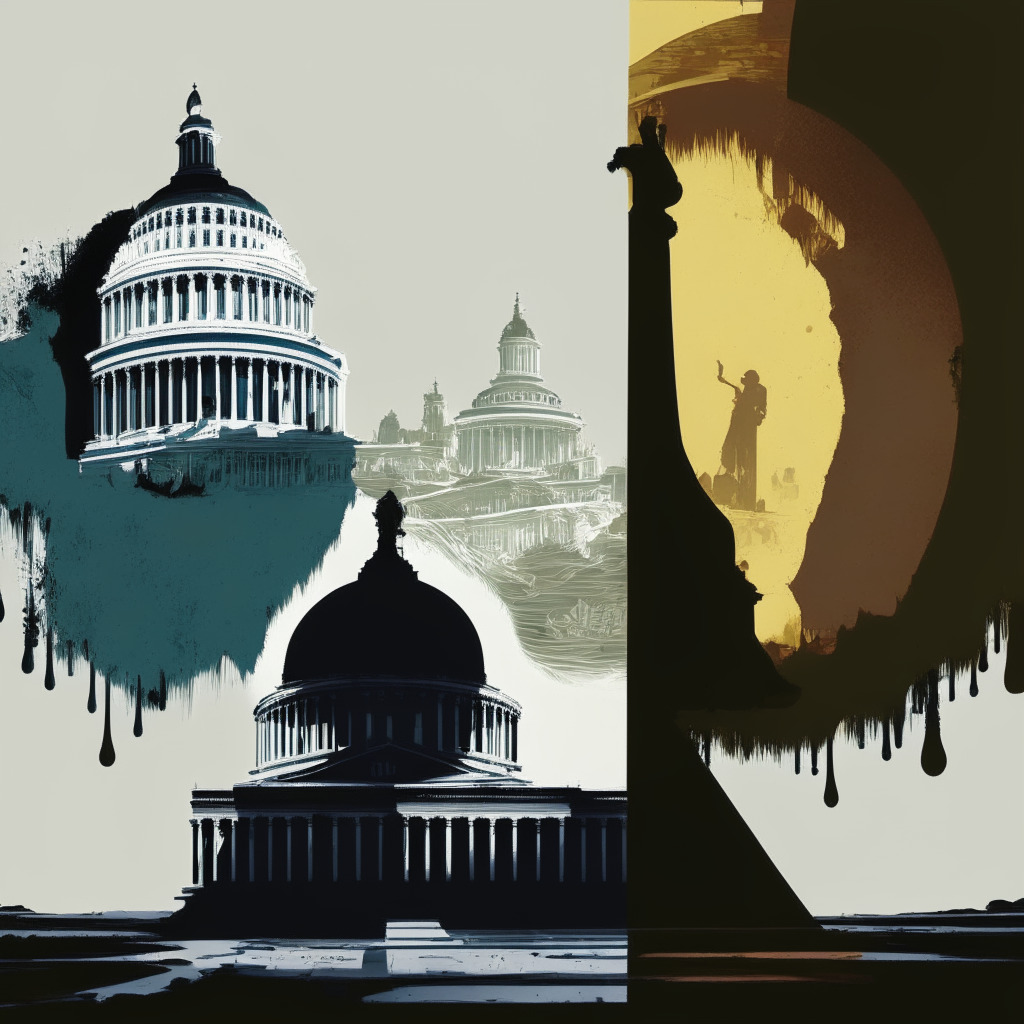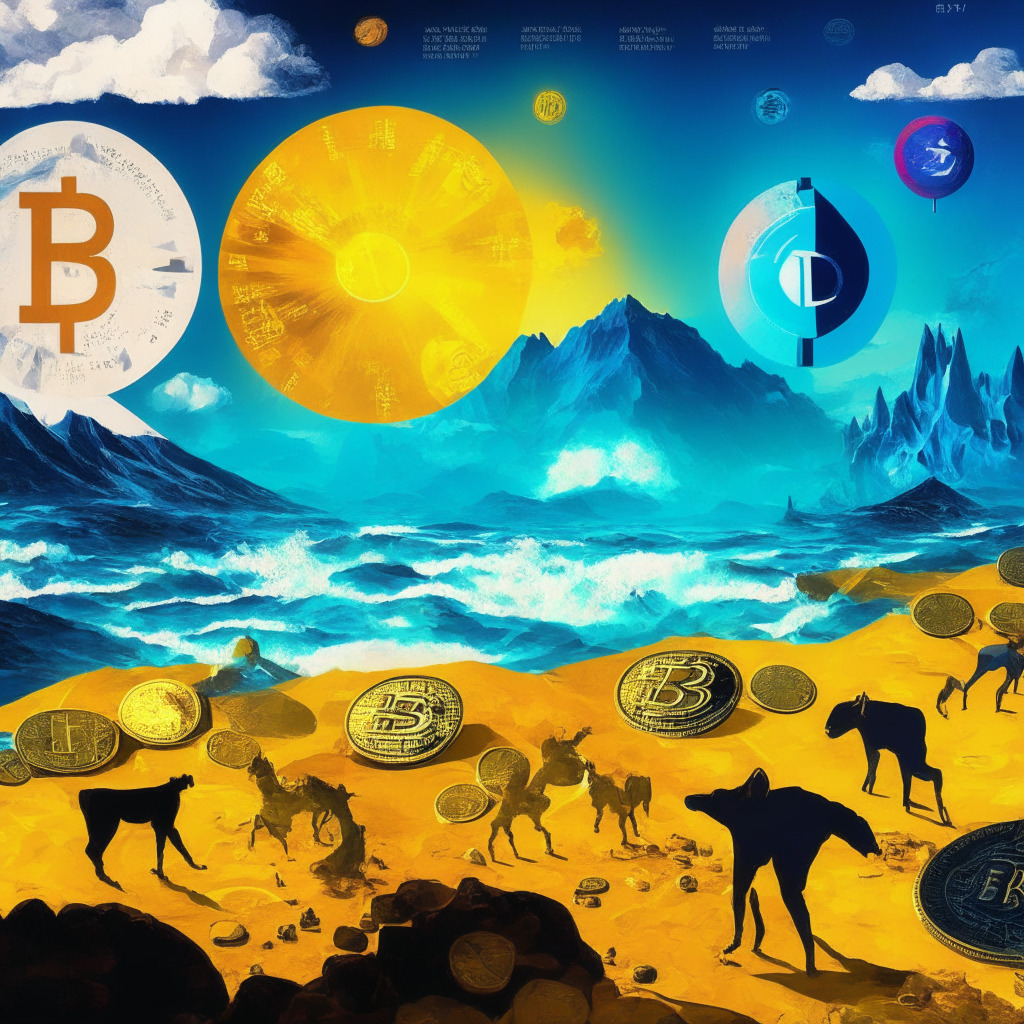According to former Federal Reserve Board analyst, Brendan Malone, stablecoins are less risky than bank deposits and are not akin to money market funds. He argues that stablecoins, backed by fiat currencies and typically short-dated Treasuries, do not pose similar risks as banks due to the absence of mismatches between short-term liabilities and long-term assets. Regulating stablecoins similarly to traditional financial entities could, however, limit competition and increase market dominance.
Search Results for: stablecoin
Stablecoin Policy Disputes: A Milestone or Impediment for Crypto Regulation?
“The Clarity for Payment Stablecoins Act (H.R. 4766) negotiations spark political debate. While some view this potential legislation as crucial for cryptocurrency regulation, others express concern about rushed decisions, lack of oversight, and regulatory dissonance. Rep. Warren Davidson’s ‘Keep Your Coins Act’ also enters the conversation, aiming to protect individual’s self-custodied crypto wallets.”
Stablecoins Legislation Deadlock: A Battle for Supervision and Inclusion in Crypto-World
“The debate in the House over stablecoins legislation reveals the significance of addressing regulatory ambiguity in the digital asset sector. Despite disagreements, legislators acknowledge the importance of stablecoins, and the outcome of this issue will inevitably influence its future regulation.”
Pacific Paradise or Peril: Palau’s Intriguing Journey into Blockchain and Stablecoins
The Pacific island nation of Palau is testing its own dollar-pegged stablecoin, with considerable assistance from Ripple. The project’s future is contingent upon a report to the nation’s government, deciding if the initiative will be fruitful long-term. Palau is also exploring blockchain technology in digital residency applications and plans to establish its own cryptocurrency exchange.
Digital Dollar Race: Wyoming’s State Stablecoin and the National Push Towards Blockchain Adoption
“Wyoming seeks to establish a state stablecoin, with the state posting a job opening for a Stable Token Commission head to create legislative frameworks for the project. Meanwhile, Texas lawmakers aim to create a gold-backed digital currency, indicating an emerging inter-state rivalry in digital currency initiatives.”
Europe Tightens the Reins on Stablecoin Issuers: A New Era or A Step Back?
The European Banking Authority (EBA) has drafted rules, known as the Markets in Crypto Assets (MiCA), introducing additional requirements for stablecoin issuers. The regulations highlight potential systemic risks associated with asset-referenced tokens (ART) and e-money tokens (EMT). Measures include additional obligations, greater supervision by the EBA, and increased reserve requirements.
Stablecoins’ Struggle for Dominance Amid Market Turbulence: A Chronicle of Ups and Downs
The recent downturn in crypto markets has led to a decreased dominance of stablecoins, with the Pax Dollar (USDP) facing a significant decrease. Despite an overall reduction in the stablecoin market, there has been a surprising increase in stablecoin trading volumes. This turbulence in the crypto space continues to influence the stablecoin market.
Scaling the Borders of Financial Freedom: Shinhan Bank Tests Stablecoin Remittances on Hedera Network
Shinhan Bank, a South Korean banking titan, completed a successful test for stablecoin remittances on Hedera’s network, allowing real-time, instantaneous settlement and foreign exchange rate integration across three currencies. This process decreases complexities and cost for cross-currency transactions, offering a solution to high intermediary bank charges in current financial structures, especially with cross-border transfers.
Ethena’s $6M Funding Success Sets Stage for Stablecoin & Bond Launch: Assessing Stability & Risks
Portuguese crypto startup, Ethena, secured $6 million in seed funding for its upcoming stablecoin and bond asset launch. Ethena’s notable funders include Dragonfly, Arthur Hayes, and major industry players like BitMEX and Gemini. The stablecoin, named USDe, promises to maintain stability, with a focus on decentralization and capital efficiency.
South Korea’s Stablecoin Feasibility Test, US Crypto Mining Firm Lawsuit, and the NEAR Foundation’s Green Pledge
Shinhan Bank in South Korea successfully carried out a feasibility test for stablecoin remittance payments using Hedera’s distributed ledger technology. Meanwhile, US crypto mining firm Marathon Digital faces legal action for alleged regulatory infringements. Cronos partners with gaming giant Ubisoft, while the NEAR Foundation pledges commitment to the Ethereum Climate Platform. Also, crypto exchange Bitget reports strong growth and Crucible offers a blockchain-based SDK for game developers.
Bipartisan Agreement on Stablecoin Regulations: A Hopeful Step or Potential Roadblock?
The Republicans and Democrats have found consensus on proposed stablecoin regulations, with the Financial Services Committee targeting state-wise legislations. The bill tasks the US Federal Reserve with enforcing regulations and could give the Commodity Futures Trading Commission more oversight over cryptocurrencies. The state vs federal regulation issue may present future challenges.
Ethena Raises $6M to Launch Ethereum-based Stablecoin: A New Face of Crypto Stability or Overhype?
Ethena, a Portugal-based startup, recently raised $6 million in seed funding to develop a novel Ethereum-based stablecoin and an online savings bond. Influential contributors involved include BitMEX founder Arthur Hayes and crypto derivatives exchanges like Deribit and Bybit. Ethena’s unique stablecoin features on-chain custody, settlement, and user-provided collateral in perpetual swaps against Ethereum.
Aave’s GHO Stablecoin Accomplishes $2.5 Million Minting in Two Days: An Insightful Analysis
Aave’s new stablecoin GHO, backed by the Ethereum network, generated $2.5 million within 48 hours of its launch. It operates under the governance of the Aave DAO community and offers robustness and dynamism through over-collateralized assets. With the release of GHO, Aave’s total locked value increased significantly, highlighting the platform’s success and market growth.
Lightning Strikes Binance: Speedy Transactions vs. Increased Complexity and a New Stablecoin on the Block
“Cryptocurrency exchange Binance has successfully incorporated the Bitcoin Lightning Network, enhancing Bitcoin transactions by enabling faster, cheaper off-chain transaction channels. In related news, decentralized finance protocol Aave has launched GHO, a dollar-pegged stablecoin, introducing a transparent, verifiable, over-collateralized asset into the crypto market.”
Techteryx Takes Over TUSD: A Significant Shift in Stablecoin Landscape or A Risky Gamble?
British Virgin Islands-based firm, Techteryx, announces readiness to take over full-operations of all offshore aspects of TUSD, the fifth largest stablecoin, including minting and redemptions, customer onboarding, and compliance from the previous manager, ArchBlock. Amidst high market capitalization of over $2.8 billion, this move casts significant implications.
Rise of Stablecoins: Will They Topple the US Dollar’s Dominance in the Digital Age?
“Jeremy Allaire, the CEO of Circle, warns of the risk to the US dollar’s status as the leading global reserve currency in the face of rising stablecoins. Allaire emphasizes the need to regulate stablecoins and develop trust in digital dollars, as cryptocurrency is poised to revolutionize the payment system, potentially saving a trillion-dollar economic toll from traditional financial system inefficiencies.”
The Rise and Uncertainty of Centralized Stablecoins: Balancing Transparency and Dependence
Centralized stablecoins, stabilizing their price against another asset like the U.S dollar, account for 75% of all transactions on centralized crypto exchanges, with TrueUSD (TUSD) and Tether’s USDT taking significant shares. However, amid growth, controversies and transparency issues pose challenges and risks, demonstrating the crypto market’s vulnerability. The future of such stablecoins depends on addressing these vulnerabilities and embracing transparency.
Stablecoins: A Tethered Threat or Necessary Innovation? Unwinding the Global Debate
“Stablecoins potentially infringe on nations’ policy sovereignty and present more benefits to robust economies like the US and Europe. They pose an economic and socio-political challenge, and also risk amplifying the dollar’s power. International sentiment points towards a need for stricter stablecoin regulation to ensure financial stability.”
Regulation Revolution: How MiCA and Euro Stablecoins Could Reshape the Crypto Landscape
The Markets in Crypto Assets (MiCA) regulation aims to introduce regulatory transparency to global crypto markets, including the creation of a European stablecoin. Amidst concerns over the U.S. economy and dollar-dominated transactions, the crypto market sees Euro-backed stablecoins as a critical alternative. This could potentially challenge the U.S. dollar’s dominance in digital asset markets.
Navigating the Regulatory Terrain for Stablecoins: Promising Future vs. Consumer Safety Debate
“The European Banking Authority is urging an early adaptation of guidelines for managing stablecoins, ahead of mandatory regulations due next year. This includes understanding and implementing the EU-approved MiCAR framework’s measures for good governance and consumer protection. These preemptive actions are designed to reduce potential risks and facilitate effective consumer protection in the rapidly evolving stablecoin market.”
Global Digital Currency Race: Stablecoins Threat or CBDCs Safety?
“The race for global digital currency dominance has stablecoins and Central Bank Digital Currencies (CBDCs) in the lead. However, Rabi Sankar, Deputy Governor of the Reserve Bank of India, warns that stablecoins could pose significant policy sovereignty risks for certain nations.”
Navigating the Tense Waters: Renminbi-Based Stablecoin Vs. China’s Digital Yuan
Jeremy Allaire, CEO of Circle, proposed that a renminbi (RMB)-based stablecoin might be better for the Chinese government than a central bank digital currency (CBDC) to increase global RMB use. However, China’s digital yuan, which isn’t positioned as a stablecoin, could create conflicts for Circle’s USD Coin.
Gho’s Spectral Leap: The High Stakes Behind Aave DAO’s Decision on Deploying the New Stablecoin
In an impactful development, Aave DAO may introduce the gho (GHO) stablecoin to the Ethereum blockchain. If approved, GHO would disrupt decentralized finance by allowing users to mint GHO against their token holdings on Aave’s platform, potentially boosting Aave DAO’s revenue.
Navigating the Roaring Tides: The Confluence of Stablecoins, CBDCs and China’s Economic Strategy
Jeremy Allaire, CEO of Circle, suggests that a Yuan-backed stablecoin could aid Beijing’s goal of widespread acceptance of the Chinese Yuan. However, he notes that strict economic policies and capital controls could be potential obstacles. Allaire highlights that despite the challenges, stablecoins have proven beneficial for overseas monetary remittances, particularly for Chinese firms.
Navigating the MiCA Legislation: Impacts on Private Stablecoins and the Future of Crypto Regulation
The European Union enacted the Markets in Crypto-Assets (MiCA) legislation, sparking controversy with a daily 200 million euros transaction cap for private stablecoins. This is meant to protect investors from large-scale stablecoin failures which could impact traditional financial systems. However, critics argue it could stifle innovation within the crypto landscape.
Navigating the Waves: Circle’s Visionary Take on Japan’s Stablecoin Market Revolution
Circle is targeting the Japanese market following that country’s new stablecoin regulations. According to CEO Jeremy Allaire, Japan has created a legal structure conducive to overseas stablecoins, which might transform it into a significant market for Circle’s USDC stablecoin. The regulations stipulate that stablecoins must be fully backed by yen or another legal tender.
Stablecoin Rise in Japan: A Regulatory Leap or a Controlled Crawl?
“Japan’s new regulations governing stablecoins could make it a hub for the burgeoning stablecoin market. However, strict rules apply: only licensed financial institutions can issue stablecoins, must be pegged to legal tender, and guarantee at-face-value redemption.”
Hong Kong’s Bid To Launch HKDG Stablecoin: A Bold Move in the Blockchain Future
“In a major move in the digital currency landscape, Hong Kong is considering the launch of its own Stablecoin, HKDG, to rival key players like USDT and USDC. The proposed Stablecoin aims to increase transaction efficiency, reduce costs, and streamline existing payment systems. HKDG’s launch could potentially shift the digital assets focus from the US dollar, promoting financial market liquidity, government investment, and infrastructure growth.”
Former Goldman Sachs Executive Joins Circle’s Board: What This Means for Future of Stablecoins
Former Goldman Sachs executive, Craig Broderick, has joined the Board of Directors of Circle Internet Financial, creator of the USDC stablecoin. Broderick’s substantial financial experience is expected to guide Circle in robust risk management, crucial in the evolving crypto environment. Concurrent with this, former CFTC chair Heath Tarbert has been recruited as Chief Legal Officer, marking a strategic push for regulatory clarity.
SAP Tests USDC Stablecoin Payments: Examining Blockchain’s Impact on Cross-Border Transactions
SAP is testing cross-border stablecoin payments using USDC on Ethereum’s Goerli testnet, aiming to improve international financial transactions. Their blockchain-based solution may offer a more efficient, transparent and cost-effective alternative to traditional cross-border payments, eliminating intermediaries and reducing fees.
Crypto Markets: Gains, Losses, and Stablecoins – Navigating the Volatile Landscape
Cryptocurrency markets exhibit notable volatility, presenting both significant gains and losses. This snapshot highlights the contrasting performance of various digital assets, emphasizing the importance of caution and due diligence when participating in the unpredictable world of digital assets.
Trader’s $4M Short on TUSD: Analyzing Stablecoin Stability Amid Issuer Challenges
A trader took a $4m short position on stablecoin TrueUSD (TUSD) after its issuer temporarily halted mints and redemptions through banking partner Prime Trust. This highlights the importance of vigilance among cryptocurrency enthusiasts, as regulatory scrutiny and operational challenges can affect the value and stability of digital assets like TUSD.































